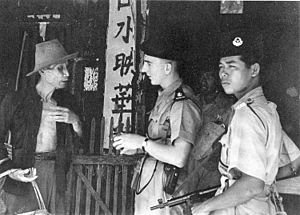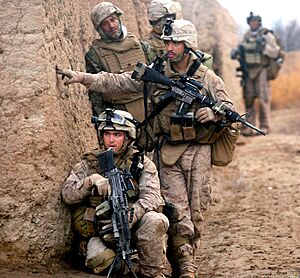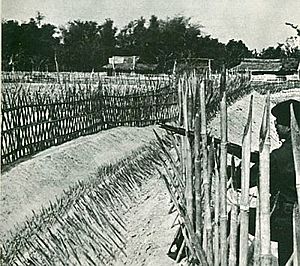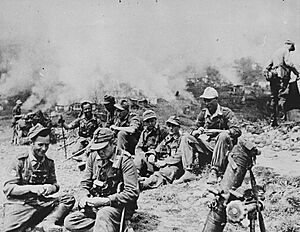Counterinsurgency facts for kids


Counterinsurgency (often called COIN) is a type of warfare. It involves all the actions a government takes to defeat "irregular forces." These irregular forces are usually rebels or guerrillas who are not part of a country's official army.
Counterinsurgency is like a war fought by a country against a group that isn't another country. This type of fighting has happened throughout history. But modern ideas about COIN became clearer during the time when many countries gained independence from colonial rule.
In these conflicts, it can be hard to tell who is a civilian and who is a fighter. Counterinsurgency might try to make people support the government. This is often called "winning hearts and minds." Sometimes, it might involve trying to scare or remove people who are thought to support the rebels.
Contents
How Counterinsurgency Works
Counterinsurgency usually combines regular military actions with other methods. These can include using propaganda to lower the morale of the rebels. It also involves actions like psychological operations (Psy-ops).
COIN operations cover many different areas. These include military, political, economic, and social efforts. They also involve psychological and community actions. All these steps are taken to defeat the rebel groups.
To understand counterinsurgency, it helps to understand what an insurgency is. Rebels often use social problems or "gaps" to gain support. When these problems are big, they create unhappiness. This unhappiness helps the rebels grow and operate. Counterinsurgency tries to fix these problems.
Tactics Used in Counterinsurgency
"Drain the Sea" Tactic
The "drain the sea" tactic means moving or removing civilians. The idea is to separate the rebels (the "fish") from the people (the "water"). This way, the rebels lose the support, hiding places, and resources from the local population.
This method often targets people who support the rebels in a specific area. Examples include events during the Second Anglo-Boer War and the Greek Civil War.
Sometimes, "draining the sea" can involve extreme violence against people blamed for supporting rebels. However, such harsh methods can make people resist even more. Today, concerns about public opinion and international law often prevent the use of extreme violence.
Targeting Leaders
Sometimes, a successful counterinsurgency tactic is to target and remove rebel leaders.
"Oil Spot" Approach

The "oil spot" approach means starting with a small, secure area. Then, the counterinsurgent forces slowly expand this safe zone. It's like an oil stain spreading on water. This idea was first used by a French military leader, Marshal Hubert Lyautey. It was also part of the plan for the Strategic Hamlet Program in South Vietnam.
Cordon and Search
Cordon and search is a military tactic. It's a basic counterinsurgency operation. An area is surrounded (cordoned off), and buildings are searched for weapons or rebels. This method is often used in city areas. The goal is to search a home with as little trouble for the family as possible.
Air Operations
Air power, like planes and helicopters, is very important in counterinsurgency. They can do many things:
- Transportation: Moving soldiers and civilians, including helping injured people.
- Intelligence: Gathering information, watching areas, and exploring.
- Psychological operations: Dropping leaflets, using loudspeakers, or radio broadcasts to influence people.
- Attacks: Attacking targets on the ground.
Building Trust with People

A key part of counterinsurgency is building trust with the local population. This is often called "public diplomacy." The goal is to make the rebels ineffective. This happens by having strong and secure relationships with the people in the area.
Understanding the local culture and environment is very important. Public diplomacy works best when leaders truly understand the people. They need to know how people interact with rebels and with aid groups. They also need to know how people view the counterinsurgency efforts themselves.
Treating prisoners and others humanely is a big part of building trust. This shows the local people that the counterinsurgency forces can be trusted. It also shows they care about the well-being of the population.

People are more likely to support the government if they expect it to provide good services and security. Programs that offer social, political, and economic help are often more valuable than military actions. These programs help fix the root causes of the conflict. They also make the local people feel safe and secure. This helps citizens trust the goals of the counterinsurgency.
The war is often fought among the people and for the people. It's a battle of ideas. These programs should be led by the local government. This shows that the counterinsurgency efforts include the local nation in their rebuilding plans.
Sharing Information Wisely
Winning a counterinsurgency also means using strategic communication and information operations well. It's a competition of ideas and beliefs. To fight rebel ideas, one must understand their values and culture. Counterinsurgency efforts need to know why people are drawn to rebel ideas. They also need to know how rebels use information to get followers.
Communication efforts need to be truthful and trustworthy. Information given to the public must never lie. Building trust means listening, paying attention, and being helpful. This helps the local people understand and trust the counterinsurgency efforts. This relationship depends on keeping promises and providing security.
Understanding how people think and what they believe is key to winning. People's view of how fair and right the government and foreign forces are determines success. Today, information flows freely through TV, phones, and the internet. This means messages must be coordinated. The counterinsurgency, the local government, and local media must work together. This helps shape how the public sees the efforts.
Public opinion, the media, and rumors all affect how people view counterinsurgency. Close relationships with local media are important. This helps make sure locals understand the goals and feel secure. If local media isn't in sync, they could spread wrong information.
Modern rebels can get support from many places, both local and global. This is thanks to better communication and globalization. So, modern counterinsurgency needs to focus on the whole system of the rebels. This means working from the national to the local level. The goal is to stop rebels from getting support and prevent new groups from forming.
See also
General:
- Civilian casualty ratio
- Collective punishment
- Death squad
- Divide and rule
- False flag
- Foreign internal defence
- Fourth generation warfare
- Guerrilla warfare
- Human rights violations
- Internally displaced people
- Irregular Warfare
- Low intensity conflict
Specific:
- Anti-partisan operations in World War II
- Bandenbekämpfung
- Clear and hold
- Counter Insurgency Force
- Strategic Hamlet
U.S. specific:
- SEAL Team Six
- Special Forces
- Special Activities Division
- Delta Force
- COINTELPRO
Police adaptations:
- C3 policing


